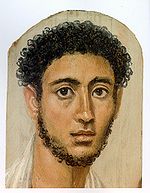Faiyum
Faiyum (Arabic: الفيوم Fayyūm, Coptic: 'Ⲫⲓⲟⲙ Paiom) is a ceety in Middle Egyp an the caipital o the Faiyum Govrenorate. It is locatit 130 km soothwast o Cairo an occupies pairt o the auncient steid o Crocodilopolis. Foondit in aroond 4000 B.C., it is the auldest ceety in Egyp an ane o the auldest in Africae.
Faiyum الفيوم | |
|---|---|
Ceety | |
| Coordinates: 29°18′0″N 30°50′0″E / 29.30000°N 30.83333°E | |
| Kintra | |
| Govrenorate | Faiyum |
| Population (2006) | |
| • Total | 316,772 |
| Time zone | UTC+2 (EST) |
Name an etymology
| |||||||
| pA-y-m (Faiyum) in hieroglyphs |
|---|
Its name in Inglis is an' a' spelled as Fayum, Fayoum, Al Fayyum or El Faiyūm. Faiyum wis previously offeecially named Madīnet el Faiyūm (Arabic for The Ceety o Faiyum). The name Faiyum (an its spellin variations) mey an' a' refer tae the Faiyum Oasis, awtho it is commonly uised bi Egyptians the day tae refer tae the ceety.[1][2]
The modren name o the ceety comes frae Coptic 'Ⲫⲓⲟⲙ /Ⲡⲉⲓⲟⲙ efiom/peiom (whence the proper name Ⲡⲁⲓⲟⲙ payom), meanin the Sea or the Lake, which in turn comes frae late Egyptian pA y-m o the same meanin, a reference tae the nearbi Lake Moeris.
Auncient ceety
Modren ceety
Faiyum haes several lairge bazaars, mosques,[3] baths an a muckle-frequentit weekly mercat. The canal cried Bahr Yussef runs throu the ceety, its banks lined wi hooses. Thare are twa brigs ower the river: ane o three airches, which cairies the main street an bazaar, an ane o twa airches, ower which is biggit the Qaitbay mosque, that wis a gift frae his wife tae honour the Mamluk Sultan in Fayoum. Moonds north o the ceety merk the site o Arsinoe, kent tae the auncient Greeks as Crocodilopolis, whaur in auncient times the sacred crocodile kept in Lake Moeris wis worshipped.[4]
The centre o the ceety is on the canal, wi the fower waterwheels, that are adoptit bi the govrenorate o Fayoum as its naitional seembol, thair chariots an bazaars are easy tae spat.
Faiyum mummy portraits

Faiyum is the soorce o some famous daith masks or mummy portraits paintit durin the Roman occupation o the aurie. The Egyptians continued thair practice o buryin thair deid, despite the Roman preference for cremation. While unner the control o the Roman Empire, Egyptian daith masks wur paintit on wid in a pigmentit wax technique cried encaustic—the Faiyum mummy portraits represent this technique.[5] While commonly believed tae represent Greek settlers in Egyp, the Faiyum portraits insteid reflect the complex synthesis o the predominant Egyptian cultur an that o the elite Greek minority in the ceety.
Undisputit remains o early anthropoids date frae the late Eocene an early Oligocene, aboot 34 million years ago, in the Fayyum aurie, soothwast o Cairo. Ane o the earliest fossil primates at Fayum is Catopithecus, datin tae aroond 35 million years ago.
Famous Steids
- Qasr Qarun, locatit 44 km frae the ceety
- Qaitbay Mosque, locatit in the ceety, an wis biggit bi the wife o the Mamluk Sultan Qaitaby
- Hanging Mosque, biggit unner the Ottoman Rule ower Egyp
- Lahun Pyramids, locatit 4 km ootside the ceety
- Hawara, aircheological site locatit 27 km frae the ceety
- Wadi Rayan, or Wadi Elrayan, the lairgest waterfaws in Egyp, locatit aroond 50 km frae the ceety
Notable fowk
Tefta Tashko-Koço, weel kent Albanian sangster wis born in Faiyum, whaur her faimily lived at that time.
See an aw
- Crocodilopolis
- Faiyum mummy portraits
- Faiyum Govrenorate
- Fayum alphabet
- Lake Moeris
- Bahr Yussef
- Roman Egyp
- Phiomia (an extinct relative o the elephant, named efter Faiyum)
- Wadi Elrayan
References
Freemit airtins
Template:Wikinewspar
- "Photo Gallery: Water Issues in Fayoum Villages". Archived frae the original on 6 September 2009. Retrieved 15 Mairch 2011.
- Falling Rain Genomics, Inc. "Geographical information on Al Fayyum, Egypt". Retrieved 29 Mairch 2008.
- P.Fayum = Fayum towns and their papyri, edited with translations and notes by Bernard P. Grenfell and Arthur S. Hunt at the Internet Archive
- Vincent L. Morgan and Spencer G. Lucas (2002). "Notes From Diary––Fayum Trip, 1907". Bulletin 22. Albuquerque: New Mexico Museum of Natural History and Science. 148 pages, public domain. ISSN 1524-4156. Archived frae the original (PDF) on 22 October 2013. Retrieved 15 Mairch 2011. freemit airtin in
|publisher=(help)
Template:Sa'id / Upper Egypt Main CitiesTemplate:Auncient Egyp topicsTemplate:Egypt oasis auries
